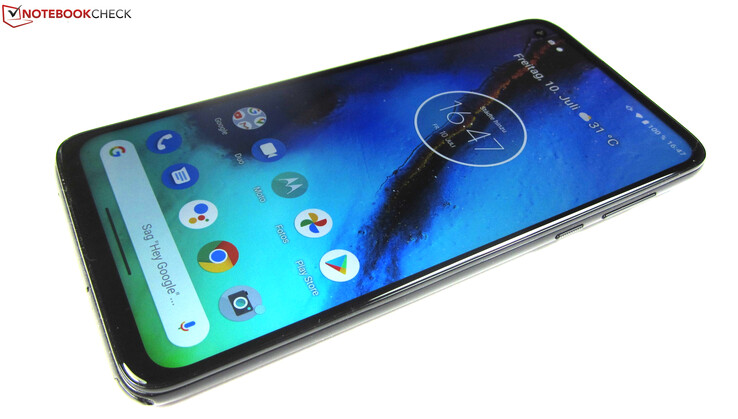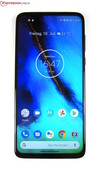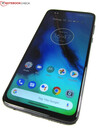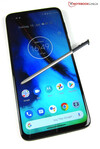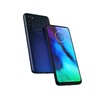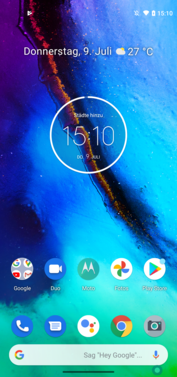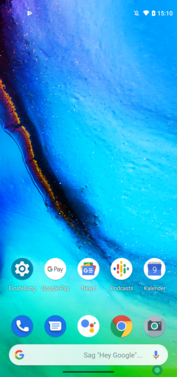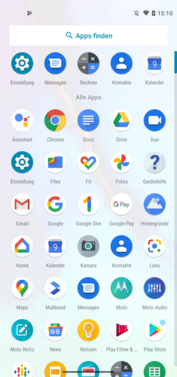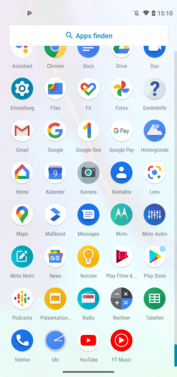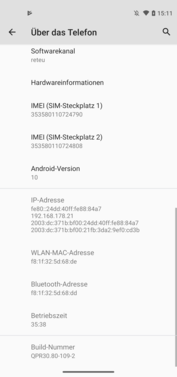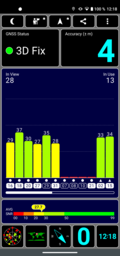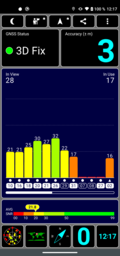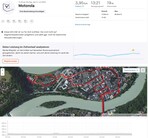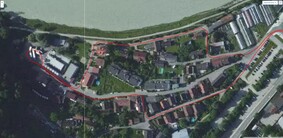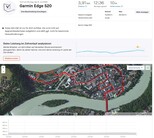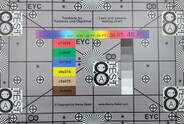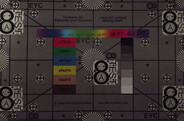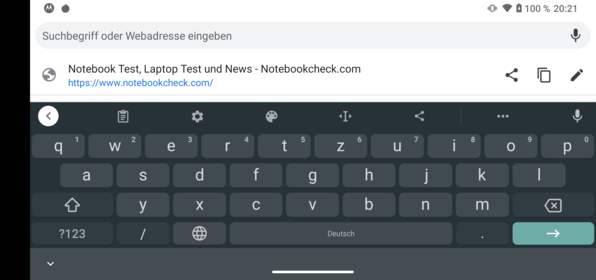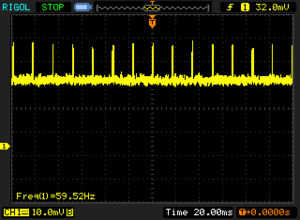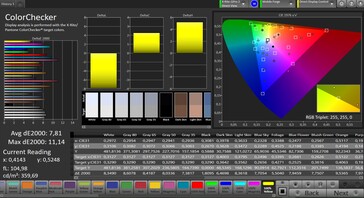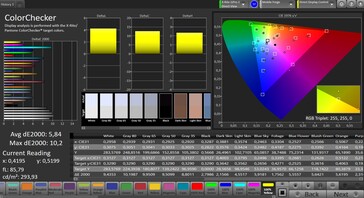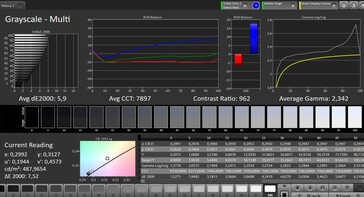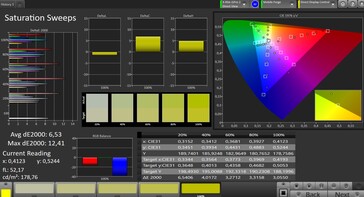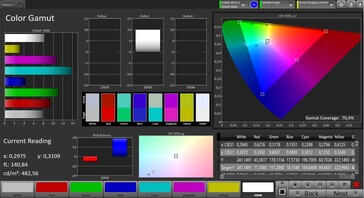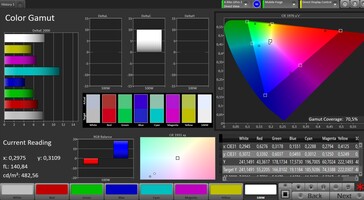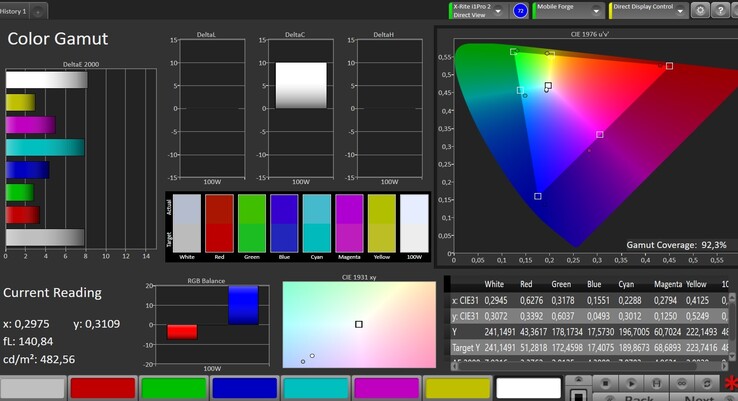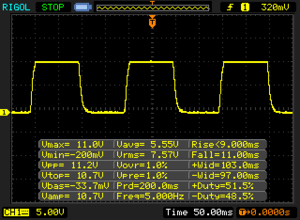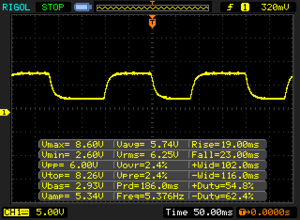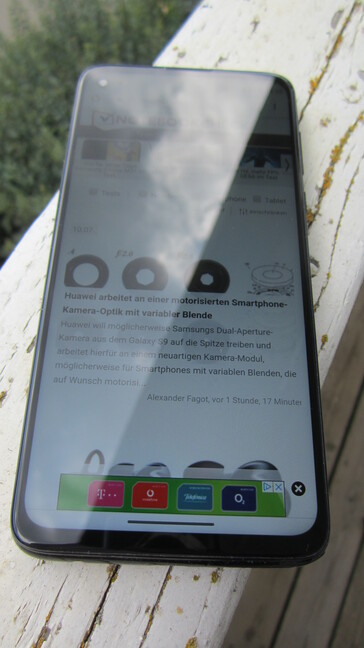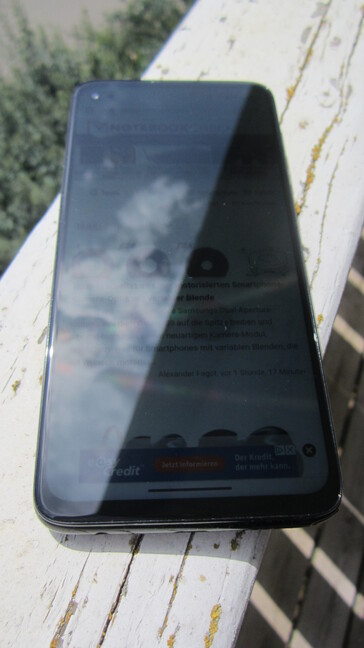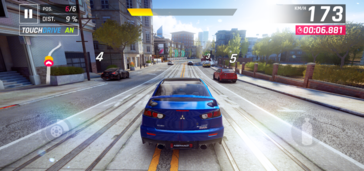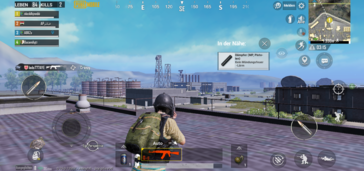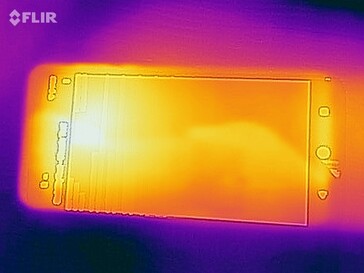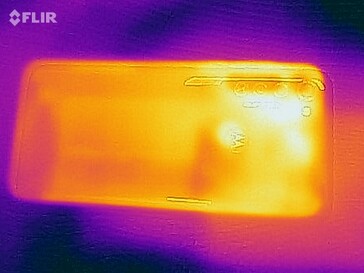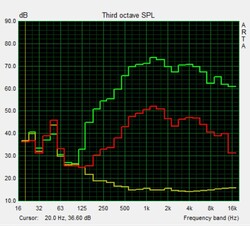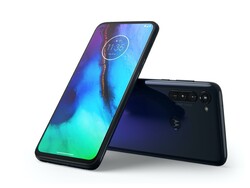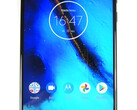Motorola Moto G Pro Smartphone Review - Inexpensive Stylus Smartphone
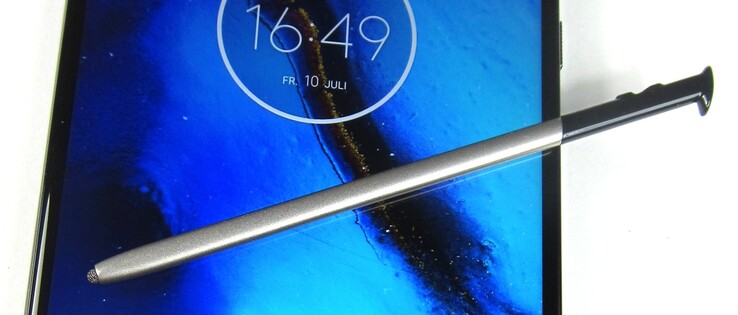
The Moto G Pro is the first smartphone from Motorola with a stylus pen. Thus, it is a direct competitor to Samsung, which dominates the stylus smartphone market with its Galaxy Note models.
Furthermore, the Moto G Pro's MSRP of only 330 Euros (~$390) is very low for a smartphone with a stylus. Meanwhile, the price of the cheapest Galaxy Note model, the Galaxy Note 10 Lite, is still significantly above 400 Euros (~$470).
It would be unfair to reduce the Moto G Pro to its stylus support, however, since the remaining features also look good on paper. With the Snapdragon 665, the Motorola is powered by a fast octa-core SoC from the upper mid-range segment. On top of that, it is equipped with 4 GB of RAM, 128 GB of internal storage, a 48-MP triple-camera system, dual SIM, NFC, and, last but not least, Android One.
Competing Devices
Rating | Date | Model | Weight | Drive | Size | Resolution | Price |
|---|---|---|---|---|---|---|---|
| 77.2 % v7 (old) | 08 / 2020 | Motorola Moto G Pro SD 665, Adreno 610 | 192 g | 128 GB eMMC Flash | 6.40" | 2300x1080 | |
| 79.3 % v7 (old) | 01 / 2020 | Xiaomi Redmi Note 8T SD 665, Adreno 610 | 200 g | 64 GB eMMC Flash | 6.30" | 2340x1080 | |
| 78.1 % v7 (old) | 03 / 2020 | Motorola Moto G8 Power SD 665, Adreno 610 | 197 g | 64 GB eMMC Flash | 6.40" | 2300x1080 | |
| 82.8 % v7 (old) | 02 / 2020 | Samsung Galaxy Note10 Lite Exynos 9810, Mali-G72 MP18 | 199 g | 128 GB UFS 2.1 Flash | 6.70" | 2400x1080 | |
| 80.3 % v6 (old) | 10 / 2018 | LG Q Stylus MT6750S, Mali-T860 MP2 | 172 g | 32 GB eMMC Flash | 6.20" | 2160x1080 |
Case - Moto G Pro with a Plastic Case and a Sleek Color Gradient
Currently, Motorola only offers the Moto G Pro in the color variant "Mystic Indigo". At first glance, the back cover appears to be black. However, depending on the angle of light incidence and the viewing angle, a subtle color gradient that shifts from black into a dark purple can be observed.
The fancy colors of the case partially make up for the plastic back. Since the Moto G Pro is very well built while also lying in the hand well thanks to its rounded-off back cover, this does not represent a major drawback, particularly when considering the low price.
The Moto G Pro is physically almost identical to the 6.3-inch Moto G8 Plus. They both share almost identical dimensions, even though the Moto G8 Plus does not come with a stylus. Since the Moto G Pro boasts a better screen-to-body ratio, its display is slightly larger at 6.4 inches.
The digital stylus is hidden in the bottom right corner, from which it can be easily removed thanks to a small notch on its side. When returned to its dock, applying pressure to the top of the stylus snaps it back into place.
The selfie camera of the Moto G Pro is located within a punch-hole notch, which has been subtly placed near the top left corner of the display. On the back, the main camera module, which houses three cameras and the laser autofocus, is also found in the top left. The fingerprint sensor has been placed on the back as well. The slightly recessed sensor is easy to locate.
Features - NFC & Headphone Jack But Only Hybrid Dual SIM
With 4 GB of RAM and 128 GB of internal storage, the Moto G Pro's memory configuration is solid. The storage can be expanded by up to 512 GB via a microSD card. In doing so, however, users of the smartphone lose the dual SIM functionality, since there is no dedicated microSD slot. The microSD card can only be used for multimedia content, whereas app data cannot be transferred over.
Furthermore, the Moto G Pro also supports Bluetooth 5.0, NFC, and USB 2.0 speeds via its USB Type-C port. Conveniently, Motorola has chosen to keep the 3.5-mm headphone jack, which allows users to connect headphones and speakers to the smartphone without the use of a USB-C adapter.
Software - At Least Two Years of Guaranteed Updates Thanks to Android One
The Moto G Pro is an Android One smartphone: It uses an Android version that is almost identical to stock Android and free from bloatware. Aside from the Google apps, only a few tools from the manufacturer such as the Moto app, Moto audio and the stylus app Moto note have been preinstalled.
Guaranteed updates are another advantage of Android One: Android One smartphones are guaranteed at least two yearly OS updates from Google as well as security patches for three years. Prospective buyers can expect the Moto G Pro, which ships with Android 10, to eventually receive Android 11 and 12. At the time of writing (middle of July), the security patches date back to May 1, making them fairly recent.
Communication and GPS - Moto G Pro with Fast Wi-Fi and Accurate GPS
Although the Moto G Pro is not exactly a smartphone for globetrotters, it covers all the LTE frequencies that are relevant in Europe. While Lenovo, Motorola's parent company, does not specify the LTE speeds, they will likely be similar to those of other Moto G models such as the Moto G8 Power (LTE Cat.13, 400 Mb/s download, 75 Mb/s upload).
Apart from NFC and Bluetooth 5.0, the Moto G Pro also has onboard Wi-Fi 5 (802.11ac) for short-range communication. In a test with our reference router Netgear Nighthawk AX12, the smartphone achieves fast and very consistent transfer rates of around 330 Mb/s for both downloads and uploads. This puts the Motorola between the slightly faster Samsung Galaxy Note 10 Lite and the Xiaomi Redmi Note 8T.
| Networking | |
| iperf3 transmit AX12 | |
| Samsung Galaxy Note10 Lite | |
| Motorola Moto G Pro | |
| Xiaomi Redmi Note 8T | |
| Motorola Moto G8 Power | |
| LG Q Stylus | |
| iperf3 receive AX12 | |
| Samsung Galaxy Note10 Lite | |
| Motorola Moto G Pro | |
| Xiaomi Redmi Note 8T | |
| LG Q Stylus | |
| Motorola Moto G8 Power | |
The Moto G Pro supports the satellite navigation systems GPS, GLONASS and Galileo. Indoors, it is able to locate us very quickly with an accuracy of within four meters, while outdoors, the accuracy improves further to be within three meters.
In our real-world GPS test, the Moto G Pro performs well. On a four-kilometer bike ride, the smartphone almost matches the precision of the professional navi Garmin Edge 520, which we brought along for comparison purposes. Although at worst, the recorded route can deviate from the actual track by a few meters, the overall accuracy of the GPS is more than adequate for day-to-day navigation tasks.
Telephony and Call Quality - Motorola Moto G Pro with High SAR Values
The Moto G Pro uses Google's default telephony app. Calls can be made via Wi-Fi and VoLTE, provided the carrier permits it.
The Moto G Pro smartphone transmits voices clearly to other cell or landline phones and reliably filters out ambient noise. In hands-free mode, both callers can be understood well.
Cameras - Good Triple-camera System with 48 MP
The triple-camera system of the Moto G Pro consists of a 48-MP main camera (f/1.7, 1.6 µm), accompanied by a 16-MP wide-angle lens (117°, f/2.2, 2.0 µm) and a 2-MP macro lens (f/2.2). As usual, the main camera combines four adjacent pixels into one, which by default results in pictures with a final resolution of 12 MP. Taking pictures at the full 48-MP resolution is not possible with the default camera app. Meanwhile, the 16-MP selfie camera also uses the quad-pixel method and produces 4-MP pictures.
The wide-angle lens - also called action cam - is only used for video recordings. It is located on the very top of the back cover above the flash, and like on the Moto G8 Plus it has been rotated by 90 degrees. As a result, videos can be captured in landscape mode, while the smartphone is held in portrait mode with one hand, which is convenient. At up to 8x, the available zoom level is identical to the photography mode.
Of course, the Moto G is capable of recording videos with the main camera as well, although this does not change the zoom factor. In order to do so, the action camera symbol in the camera software has to be tapped to switch back from the wide-angle to the main lens. However, the lenses cannot be switched between while recording.
While the action camera supports video recordings at up to Full HD and 60 frames per second, the main camera can capture up to 4K UHD with 30 FPS. The selfie camera is limited to Full HD video at 30 frames per second.
In good lighting, the Moto G Pro can take excellent pictures that impress with natural colors and great details. Overall, the results are good enough to rival those of significantly more expensive smartphones. In low-light situations, the camera still captures a great level of detail and the colors remain quite accurate as well.
Image comparison
Choose a scene and navigate within the first image. One click changes the position on touchscreens. One click on the zoomed-in image opens the original in a new window. The first image shows the scaled photograph of the test device.
Daylight scene 1Daylight scene 2Low-light environmentWhile the analysis of the ColorChecker passport under controlled lighting conditions shows that the color reproduction of the main camera is not quite ideal, the colors accuracy is still relatively high. Although the center of the test chart looks sharp, the edges appear pale and blurry.
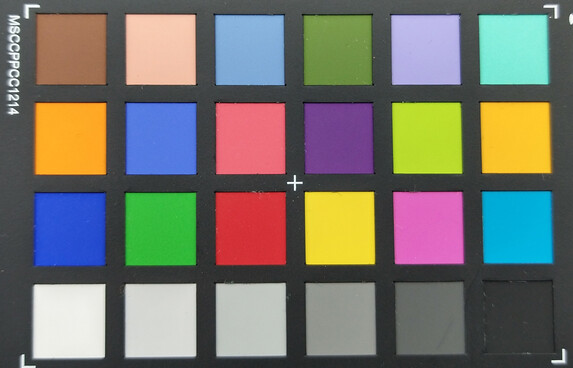
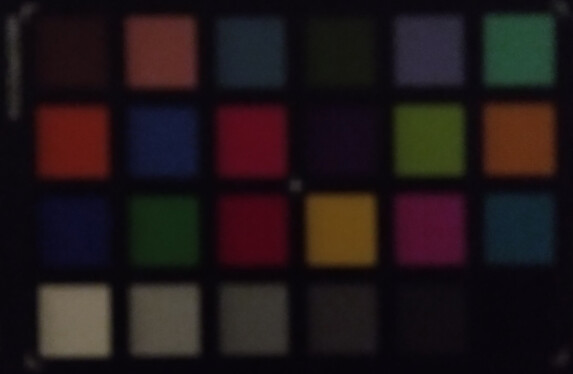
Accessories and Warranty - 18-watt Charger Included
Motorola includes a modular 18-watt charger, a USB cable (Type-A to Type-C), a SIM tool, a quick-start guide, and a pamphlet with warranty information with the Moto G Pro. There are no specific accessories available for the smartphone from the manufacturer. That being said, various accessories such as wireless and wired headphones can be purchased from Motorola's online shop.
The warranty period for the Moto G Pro is 24 months.
Input Devices & Handling - Moto G Pro with a Well-executed Stylus Concept
The octa-core Snapdragon 665 SoC powers the Moto G Pro for a smooth Android experience. The touchscreen is responsive, and the fingerprint sensor and the facial recognition are equally as reliable. The Moto app offers an even greater degree of comfort and allows users to define various gestures.
Pulling the surprisingly heavy stylus out of its dock immediately shows the stylus menu on the smartphone. Whenever it is inactive, it transforms into a smaller, semi-transparent icon that remains fixed on the screen regardless of the app or menu in the foreground. Via drag and drop, the stylus icon can be dragged to any position on the display.
Notes or sketches can be created by selecting the corresponding applet from the stylus menu. Apps such as the sketch tool Moto note can also be set to launch automatically when the stylus is removed from its slot. Naturally, the stylus pen can be used to navigate Android menus as well.
Overall, navigating the smartphone with the stylus feels very fast. However, the responsiveness advantages of more-expensive Galaxy Note models become apparent when drawing sketches. There is a small delay between the input and onscreen execution. While this is not an issue while navigating the menus, it becomes more and more apparent as the speed at which the stylus is dragged across the screen while drawing increases. Overall, the small input delay does not detract from the user experience.
Display - Bright IPS Panel with a High Brightness
The 6.4-inch IPS display of the Moto G Pro has a resolution of 2300x1080 pixels, resulting in a pixel density of 399 PPI, which is common for this device class. By contrast, the luminance exceeds the norm: At an average of 732 cd/m², the display is very bright for a mid-range smartphone.
With an even distribution of bright and dark areas (APL50), the maximum brightness still holds firm at 706 cd/m². Unfortunately, the display uses pulse-width modulation to control the brightness, which may cause issues for sensitive users.
| |||||||||||||||||||||||||
Brightness Distribution: 97 %
Center on Battery: 735 cd/m²
Contrast: 1470:1 (Black: 0.5 cd/m²)
ΔE ColorChecker Calman: 5.84 | ∀{0.5-29.43 Ø4.83}
ΔE Greyscale Calman: 5.9 | ∀{0.09-98 Ø5.1}
92.3% sRGB (Calman 2D)
Gamma: 2.342
CCT: 7897 K
| Motorola Moto G Pro IPS, 2300x1080, 6.4" | Xiaomi Redmi Note 8T IPS, 2340x1080, 6.3" | Motorola Moto G8 Power IPS, 2300x1080, 6.4" | Samsung Galaxy Note10 Lite AMOLED, 2400x1080, 6.7" | LG Q Stylus IPS, 2160x1080, 6.2" | |
|---|---|---|---|---|---|
| Screen | 11% | -19% | -16% | -7% | |
| Brightness middle | 735 | 628 -15% | 462 -37% | 510 -31% | 458 -38% |
| Brightness | 732 | 631 -14% | 483 -34% | 536 -27% | 441 -40% |
| Brightness Distribution | 97 | 93 -4% | 93 -4% | 91 -6% | 94 -3% |
| Black Level * | 0.5 | 0.54 -8% | 0.65 -30% | 0.51 -2% | |
| Contrast | 1470 | 1163 -21% | 711 -52% | 898 -39% | |
| Colorchecker dE 2000 * | 5.84 | 2 66% | 5.7 2% | 6.6 -13% | 4.5 23% |
| Colorchecker dE 2000 max. * | 10.2 | 5.1 50% | 8.9 13% | 17.56 -72% | 7.1 30% |
| Greyscale dE 2000 * | 5.9 | 3.7 37% | 6.5 -10% | 2.9 51% | 5.1 14% |
| Gamma | 2.342 94% | 2.17 101% | 2.303 96% | 2.242 98% | 2.33 94% |
| CCT | 7897 82% | 6230 104% | 8073 81% | 6989 93% | 7381 88% |
* ... smaller is better
Screen Flickering / PWM (Pulse-Width Modulation)
| Screen flickering / PWM detected | 59.5 Hz | ≤ 15 % brightness setting | |
The display backlight flickers at 59.5 Hz (worst case, e.g., utilizing PWM) Flickering detected at a brightness setting of 15 % and below. There should be no flickering or PWM above this brightness setting. The frequency of 59.5 Hz is very low, so the flickering may cause eyestrain and headaches after extended use. In comparison: 53 % of all tested devices do not use PWM to dim the display. If PWM was detected, an average of 8320 (minimum: 5 - maximum: 343500) Hz was measured. | |||
Thanks to its high black value of 0.29 cd/m², the screen content is rich in contrast and vivid. Conversely, the color accuracy is not particularly high, although it is still satisfactory for a smartphone display. Meanwhile, the slight blue tint that is present on the IPS panel is harder to ignore and manifests in an overly cool display.
Display Response Times
| ↔ Response Time Black to White | ||
|---|---|---|
| 20 ms ... rise ↗ and fall ↘ combined | ↗ 9 ms rise | |
| ↘ 11 ms fall | ||
| The screen shows good response rates in our tests, but may be too slow for competitive gamers. In comparison, all tested devices range from 0.1 (minimum) to 240 (maximum) ms. » 41 % of all devices are better. This means that the measured response time is similar to the average of all tested devices (20.5 ms). | ||
| ↔ Response Time 50% Grey to 80% Grey | ||
| 42 ms ... rise ↗ and fall ↘ combined | ↗ 19 ms rise | |
| ↘ 23 ms fall | ||
| The screen shows slow response rates in our tests and will be unsatisfactory for gamers. In comparison, all tested devices range from 0.165 (minimum) to 636 (maximum) ms. » 66 % of all devices are better. This means that the measured response time is worse than the average of all tested devices (32 ms). | ||
Due to its high luminosity, the screen of the Moto G Pro can still be read well in bright ambient light. Even in direct sunlight, the screen content remains somewhat readable.
As per usual, the viewing angles of the IPS display are good. When viewing the display from a steep angle, the perceived brightness slightly increases.
Performance - Solid Mid-range Performance
The Moto G Pro is powered by the Snapdragon 665, a mid-range SoC with 8 cores. It easily provides sufficient performance for daily tasks such as web browsing, WhatsApp, and YouTube.
In synthetic benchmarks, the Motorola goes head-to-head with the Xiaomi Redmi Note 8T and the Motorola Moto G8 Power, both of which are equipped with the same SoC. Compared to the somewhat dated stylus competitor LG Q Stylus, the Moto G Pro has a significant performance advantage. When it comes to graphics-intensive workloads, the Samsung Galaxy Note 10 Lite is the clear winner in this comparison, however.
| PCMark for Android | |
| Work performance score (sort by value) | |
| Motorola Moto G Pro | |
| Motorola Moto G8 Power | |
| Samsung Galaxy Note10 Lite | |
| LG Q Stylus | |
| Average Qualcomm Snapdragon 665 (7437 - 9051, n=10) | |
| Work 2.0 performance score (sort by value) | |
| Motorola Moto G Pro | |
| Xiaomi Redmi Note 8T | |
| Motorola Moto G8 Power | |
| Samsung Galaxy Note10 Lite | |
| Average Qualcomm Snapdragon 665 (6189 - 11432, n=12) | |
| GFXBench 3.1 | |
| on screen Manhattan ES 3.1 Onscreen (sort by value) | |
| Motorola Moto G Pro | |
| Motorola Moto G8 Power | |
| Samsung Galaxy Note10 Lite | |
| LG Q Stylus | |
| Average Qualcomm Snapdragon 665 (10 - 27, n=10) | |
| Average of class Smartphone (8.9 - 166, n=161, last 2 years) | |
| 1920x1080 Manhattan ES 3.1 Offscreen (sort by value) | |
| Motorola Moto G Pro | |
| Motorola Moto G8 Power | |
| Samsung Galaxy Note10 Lite | |
| LG Q Stylus | |
| Average Qualcomm Snapdragon 665 (13 - 13, n=10) | |
| Average of class Smartphone (8.4 - 365, n=161, last 2 years) | |
| AnTuTu v8 - Total Score (sort by value) | |
| Motorola Moto G Pro | |
| Motorola Moto G8 Power | |
| Samsung Galaxy Note10 Lite | |
| Average Qualcomm Snapdragon 665 (167305 - 181432, n=9) | |
While the Moto G Pro does not reach the highest browser benchmark scores compared to other mid-range offerings, this barely affects daily use, since web pages and their embedded content still load quickly. However, the Samsung Galaxy Note 10 Lite once again takes first place in our comparison.
| Jetstream 2 - 2.0 Total Score | |
| Average of class Smartphone (13.8 - 387, n=154, last 2 years) | |
| Samsung Galaxy Note10 Lite (Chrome 80) | |
| Motorola Moto G Pro (Chrome 83.0.4103.106) | |
| Average Qualcomm Snapdragon 665 (22.9 - 31.2, n=6) | |
| JetStream 1.1 - Total Score | |
| Samsung Galaxy Note10 Lite (Chrome 80) | |
| Motorola Moto G Pro (Chrome 83.0.4103.106) | |
| Motorola Moto G8 Power (Chrome 80) | |
| Average Qualcomm Snapdragon 665 (33.4 - 51, n=8) | |
| LG Q Stylus (hrome 69) | |
| Speedometer 2.0 - Result | |
| Average of class Smartphone (15.2 - 585, n=137, last 2 years) | |
| Samsung Galaxy Note10 Lite (Chome 80) | |
| Average Qualcomm Snapdragon 665 (25.4 - 30.8, n=6) | |
| Motorola Moto G Pro (Chrome 83.0.4103.106) | |
| WebXPRT 3 - Overall | |
| Average of class Smartphone (38 - 347, n=55, last 2 years) | |
| Samsung Galaxy Note10 Lite (Chrome 80) | |
| Motorola Moto G8 Power (Chrome 80) | |
| Motorola Moto G Pro (Chrome 83.0.4103.106) | |
| Average Qualcomm Snapdragon 665 (38 - 58, n=9) | |
| LG Q Stylus (Chrome 69) | |
| Octane V2 - Total Score | |
| Average of class Smartphone (2228 - 100368, n=204, last 2 years) | |
| Samsung Galaxy Note10 Lite (Chrome 80) | |
| Motorola Moto G Pro (Chrome 83.0.4103.106) | |
| Average Qualcomm Snapdragon 665 (6133 - 9671, n=9) | |
| Motorola Moto G8 Power (Chrome 80) | |
| LG Q Stylus (hrome 69) | |
| Mozilla Kraken 1.1 - Total | |
| LG Q Stylus (hrome 69) | |
| Average Qualcomm Snapdragon 665 (4434 - 6719, n=9) | |
| Motorola Moto G8 Power (Chrome 80) | |
| Motorola Moto G Pro (Chrome 83.0.4103.106) | |
| Samsung Galaxy Note10 Lite (Chrome 80) | |
| Average of class Smartphone (277 - 28190, n=158, last 2 years) | |
* ... smaller is better
With sequential read and write speeds of 300 MB/s and 230 MB/s, respectively, the internal storage of the Moto G Pro is on par with its closest competitors, the Xiaomi Redmi Note 8T and Motorola Moto G8 Power. However, the trio does not stand a chance against the Samsung Galaxy Note 10 Lite. Meanwhile, the playing field is more even in terms of reading from and writing to microSD cards, where the somewhat dated LG Q Stylus surprisingly achieves the best performance.
| Motorola Moto G Pro | Xiaomi Redmi Note 8T | Motorola Moto G8 Power | Samsung Galaxy Note10 Lite | LG Q Stylus | Average 128 GB eMMC Flash | Average of class Smartphone | |
|---|---|---|---|---|---|---|---|
| AndroBench 3-5 | 2% | 0% | 52% | -30% | -1% | 479% | |
| Sequential Read 256KB | 294.1 | 315.8 7% | 300.9 2% | 777 164% | 241.7 -18% | 294 ? 0% | 2168 ? 637% |
| Sequential Write 256KB | 233.6 | 173.9 -26% | 181.9 -22% | 190.8 -18% | 121.4 -48% | 195.5 ? -16% | 1761 ? 654% |
| Random Read 4KB | 65.5 | 90.4 38% | 57.7 -12% | 132 102% | 31.45 -52% | 84.6 ? 29% | 294 ? 349% |
| Random Write 4KB | 89.4 | 91.2 2% | 132.6 48% | 142 59% | 12.07 -86% | 57.9 ? -35% | 337 ? 277% |
| Sequential Read 256KB SDCard | 73.4 ? | 71.6 ? -2% | 69.4 ? -5% | 73.5 ? 0% | 83.1 ? 13% | 78.1 ? 6% | |
| Sequential Write 256KB SDCard | 55.9 ? | 52.8 ? -6% | 49.7 ? -11% | 59.8 ? 7% | 63.5 ? 14% | 61.8 ? 11% |
Gaming - Moto G with Limitations
The Snapdragon 665 SoC's integrated graphics chip Adreno 610 belongs to the lower mid-range in terms of performance. Games, including recent titles, run relatively smoothly. However, the graphics settings often need to be toned down in order to achieve smooth frame rates.
Otherwise, users can expect results matching our Asphalt 9: Legends test. With our test tool Gamebench, we recorded a choppy average frame rate of 11 FPS - this is far removed from an enjoyable experience. PUBG Mobile takes a more proactive approach: Here, the HD graphics setting is not available in the first place, and instead users may choose between the two low-end settings smooth and balanced. With the latter, our test device reaches an average of 25 FPS. Although this is not entirely smooth, it is playable.
Emissions - Good Dolby Speakers, No Throttling under Load
Temperature
With a maximum temperature of 28.5 °C, the heat development of the Moto G Pro is entirely unproblematic during idle. While the temperatures rise significantly under load, a peak value of 43.9 °C means that it can still be held fairly comfortably.
Despite the relatively high surface temperatures under load, the internal heat management of the Moto G Pro is good. The GFXBench battery test confirms this. Even after rendering the test scenarios T-Rex and Manhattan in a loop 30 times each, the frame rates remain as high as in the beginning of the test.
(±) The maximum temperature on the upper side is 43.9 °C / 111 F, compared to the average of 35.2 °C / 95 F, ranging from 21.9 to 247 °C for the class Smartphone.
(±) The bottom heats up to a maximum of 44.1 °C / 111 F, compared to the average of 34 °C / 93 F
(+) In idle usage, the average temperature for the upper side is 27.7 °C / 82 F, compared to the device average of 32.9 °C / 91 F.
Speakers
The list of advantages includes the Moto G Pro's stereo speakers featuring Dolby technology. For a mid-range phone, the audio is excellent. That being said, the measurements show that they lack bass almost entirely and reach a rather low maximum volume level of 81.9 dB(A).
Via the 3.5-mm headphone jack and Bluetooth 5.0, external audio devices such as headphones and speakers can be connected to the Moto G Pro. Furthermore, the audio codec aptX is supported.
Motorola Moto G Pro audio analysis
(±) | speaker loudness is average but good (81.9 dB)
Bass 100 - 315 Hz
(-) | nearly no bass - on average 67.2% lower than median
(+) | bass is linear (0% delta to prev. frequency)
Mids 400 - 2000 Hz
(-) | nearly no mids - on average 67.2% lower than median
(+) | mids are linear (0% delta to prev. frequency)
Highs 2 - 16 kHz
(-) | nearly no highs - on average 67.2% lower than median
(+) | highs are linear (0% delta to prev. frequency)
Overall 100 - 16.000 Hz
(-) | overall sound is not linear (118.9% difference to median)
Compared to same class
» 87% of all tested devices in this class were better, 9% similar, 4% worse
» The best had a delta of 12%, average was 36%, worst was 134%
Compared to all devices tested
» 96% of all tested devices were better, 3% similar, 1% worse
» The best had a delta of 4%, average was 24%, worst was 134%
Motorola Moto G8 Power audio analysis
(+) | speakers can play relatively loud (85.1 dB)
Bass 100 - 315 Hz
(-) | nearly no bass - on average 73.8% lower than median
(+) | bass is linear (0% delta to prev. frequency)
Mids 400 - 2000 Hz
(-) | nearly no mids - on average 73.8% lower than median
(+) | mids are linear (0% delta to prev. frequency)
Highs 2 - 16 kHz
(-) | nearly no highs - on average 73.8% lower than median
(+) | highs are linear (0% delta to prev. frequency)
Overall 100 - 16.000 Hz
(-) | overall sound is not linear (125.7% difference to median)
Compared to same class
» 96% of all tested devices in this class were better, 4% similar, 1% worse
» The best had a delta of 12%, average was 36%, worst was 134%
Compared to all devices tested
» 99% of all tested devices were better, 1% similar, 0% worse
» The best had a delta of 4%, average was 24%, worst was 134%
Battery Life - Enough Power for at Least One Day
Energy Consumption
While the Moto G Pro's energy consumption is nothing out of the ordinary, it is not quite as economical as most of its competitors.
With the included 18-watt charger, the Motorola phone can be quickly charged. In our test, fully recharging the 4200-mAh battery took almost 2 h 40 m.
| Off / Standby | |
| Idle | |
| Load |
|
Key:
min: | |
| Motorola Moto G Pro 4000 mAh | Xiaomi Redmi Note 8T 4000 mAh | Motorola Moto G8 Power 5000 mAh | Samsung Galaxy Note10 Lite 4500 mAh | LG Q Stylus 3300 mAh | Average Qualcomm Snapdragon 665 | Average of class Smartphone | |
|---|---|---|---|---|---|---|---|
| Power Consumption | 30% | 30% | -9% | 34% | 17% | -0% | |
| Idle Minimum * | 1.6 | 0.62 61% | 0.9 44% | 0.9 44% | 0.69 57% | 1.017 ? 36% | 0.868 ? 46% |
| Idle Average * | 2.3 | 1.77 23% | 1.3 43% | 1.6 30% | 1.7 26% | 1.893 ? 18% | 1.426 ? 38% |
| Idle Maximum * | 2.8 | 1.8 36% | 1.6 43% | 1.9 32% | 1.73 38% | 2.36 ? 16% | 1.588 ? 43% |
| Load Average * | 4.2 | 3.42 19% | 3.2 24% | 8.4 -100% | 3.21 24% | 3.77 ? 10% | 7.17 ? -71% |
| Load Maximum * | 6.9 | 6.14 11% | 7.1 -3% | 10.3 -49% | 5.31 23% | 6.66 ? 3% | 10.8 ? -57% |
* ... smaller is better
Battery Life
In our battery test, the Moto G Pro lasts slightly above 13 hours. The runtime during H.264 video playback is even higher at almost 15 hours. Overall, one battery charge should easily last for at least one day, even with intensive use.
| Motorola Moto G Pro 4000 mAh | Xiaomi Redmi Note 8T 4000 mAh | Motorola Moto G8 Power 5000 mAh | Samsung Galaxy Note10 Lite 4500 mAh | LG Q Stylus 3300 mAh | |
|---|---|---|---|---|---|
| Battery Runtime | -4% | 27% | 5% | -39% | |
| Reader / Idle | 2450 | 2205 -10% | 1529 -38% | ||
| H.264 | 882 | 1071 21% | 527 -40% | ||
| WiFi v1.3 | 792 | 764 -4% | 1002 27% | 904 14% | 419 -47% |
| Load | 290 | 274 -6% | 200 -31% |
Pros
Cons
Verdict - Motorola Moto G Pro Is a Force to Be Reckoned with
An inexpensive smartphone with a stylus - with the Moto G Pro, Motorola has filled this niche and released a serious competitor to Samsung's Galaxy Note series.
For 330 Euros (~$390), buyers get a well-equipped mid-range smartphone with a stylus that, even though it cannot quite match the precision of its Samsung counterpart, is well suited to daily use.
If you are looking for an inexpensive smartphone with a stylus, the Motorola Moto G Pro is definitely worth considering.
Our only complaint regarding the stylus relates to the phone's name - "Moto G Pro" does not in any way hint at the fact that users of the smartphone benefit from the advantages that stylus inputs can provide. Although interestingly, the US version of the Moto G Pro is called "Moto G Stylus", its feature set is worse: There is neither dual SIM nor NFC support, and instead of the 18-watt charger it only comes with a 10-watt model.
Back to the Moto G Pro: Apart from its stylus and the other aforementioned advantages, the user experience is further enhanced by features such as Dolby speakers, a bright IPS display, a good camera and fast Wi-Fi. As an Android One device, it is guaranteed to receive software updates for the coming two years.
Motorola Moto G Pro
- 07/14/2020 v7 (old)
Manuel Masiero




